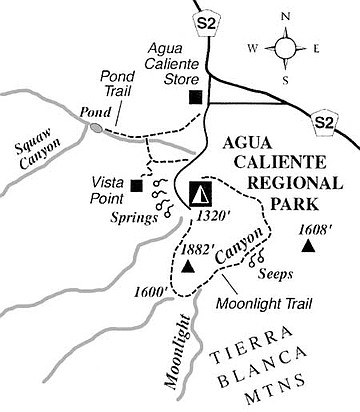 Facebook
Facebook
 X
X
 Instagram
Instagram
 TikTok
TikTok
 Youtube
Youtube
Remotely situated at San Diego County’s far east side and surrounded by Anza-Borrego Desert State Park, Agua Caliente Regional Park draws winter visitors to its comfortable warm and hot bathing pools and its homey campground. Several hiking trails lace the park, all of which are perfect for casual hiking with kids. The particular trail covered in this column leads to small freshwater marsh (which the park calls “the pond”) where groundwater saturates the sandy soil and nourishes a riparian oasis of willows and palms.
First, how to get there: From most of the San Diego city area, the fastest and easiest route is Interstate 8 east to Ocotillo in Imperial County. From Ocotillo, follow Highway S-2 northwest for 27 miles to Agua Caliente, on the left. Inland North County residents may find it quicker to go through Julian on Highway 78, down the Banner Grade east of Julian to Scissors Crossing (junction of Highway S-2), and then southeast on S-2 for 22 miles.
This being a county park, be prepared to pay an entrance fee, whether for day use or for overnight camping (call County Parks at 858-565-3600 for camping reservations).
Pick up the trail to the pond at the campfire circle near the entrance to Agua Caliente Regional Park. You wind west over a low ridge, passing a spur trail leading south to an overlook, then descend to a dry, sandy wash. Turn left and make your way past thickets of thorny mesquite bushes, which are vibrant green when leafing out in February or March. The nutritious pealike pods of the mesquite ripen in September and are eaten by various mammals.
Ahead lies the pond — a marshy area with several large willow trees and some small palm trees. At least one diamondback rattlesnake makes a living on the small furry creatures that come here to drink. Coyotes and bobcats also frequent this little oasis. On the nearby hillsides you can admire the natural gardens of barrel and teddy-bear-cholla cactus. The latter cactus, especially, is nice to look at from a distance, but up close reveals bristles of stiff and incredibly sharp spines.
Just beyond the pond, in a jagged ravine to the south (named Squaw Canyon on topographic maps), is a small cave, a tinaja (a natural rock tank) and a usually dry waterfall. Further exploration is possible up any of the several branches of the canyon.
This article contains information about a publicly owned recreation or wilderness area. Trails and pathways are not necessarily marked. Conditions can change rapidly. Hikers should be properly equipped and have safety and navigational skills. The Reader and Jerry Schad assume no responsibility for any adverse experience.
The Pond at Agua Caliente
A mini-freshwater marsh awaits your inspection at Agua Caliente Regional Park in the Anza-Borrego Desert.
Distance from downtown San Diego: 100 miles
Hiking length: 1.4 miles round trip
Difficulty: Easy


Remotely situated at San Diego County’s far east side and surrounded by Anza-Borrego Desert State Park, Agua Caliente Regional Park draws winter visitors to its comfortable warm and hot bathing pools and its homey campground. Several hiking trails lace the park, all of which are perfect for casual hiking with kids. The particular trail covered in this column leads to small freshwater marsh (which the park calls “the pond”) where groundwater saturates the sandy soil and nourishes a riparian oasis of willows and palms.
First, how to get there: From most of the San Diego city area, the fastest and easiest route is Interstate 8 east to Ocotillo in Imperial County. From Ocotillo, follow Highway S-2 northwest for 27 miles to Agua Caliente, on the left. Inland North County residents may find it quicker to go through Julian on Highway 78, down the Banner Grade east of Julian to Scissors Crossing (junction of Highway S-2), and then southeast on S-2 for 22 miles.
This being a county park, be prepared to pay an entrance fee, whether for day use or for overnight camping (call County Parks at 858-565-3600 for camping reservations).
Pick up the trail to the pond at the campfire circle near the entrance to Agua Caliente Regional Park. You wind west over a low ridge, passing a spur trail leading south to an overlook, then descend to a dry, sandy wash. Turn left and make your way past thickets of thorny mesquite bushes, which are vibrant green when leafing out in February or March. The nutritious pealike pods of the mesquite ripen in September and are eaten by various mammals.
Ahead lies the pond — a marshy area with several large willow trees and some small palm trees. At least one diamondback rattlesnake makes a living on the small furry creatures that come here to drink. Coyotes and bobcats also frequent this little oasis. On the nearby hillsides you can admire the natural gardens of barrel and teddy-bear-cholla cactus. The latter cactus, especially, is nice to look at from a distance, but up close reveals bristles of stiff and incredibly sharp spines.
Just beyond the pond, in a jagged ravine to the south (named Squaw Canyon on topographic maps), is a small cave, a tinaja (a natural rock tank) and a usually dry waterfall. Further exploration is possible up any of the several branches of the canyon.
This article contains information about a publicly owned recreation or wilderness area. Trails and pathways are not necessarily marked. Conditions can change rapidly. Hikers should be properly equipped and have safety and navigational skills. The Reader and Jerry Schad assume no responsibility for any adverse experience.
The Pond at Agua Caliente
A mini-freshwater marsh awaits your inspection at Agua Caliente Regional Park in the Anza-Borrego Desert.
Distance from downtown San Diego: 100 miles
Hiking length: 1.4 miles round trip
Difficulty: Easy
